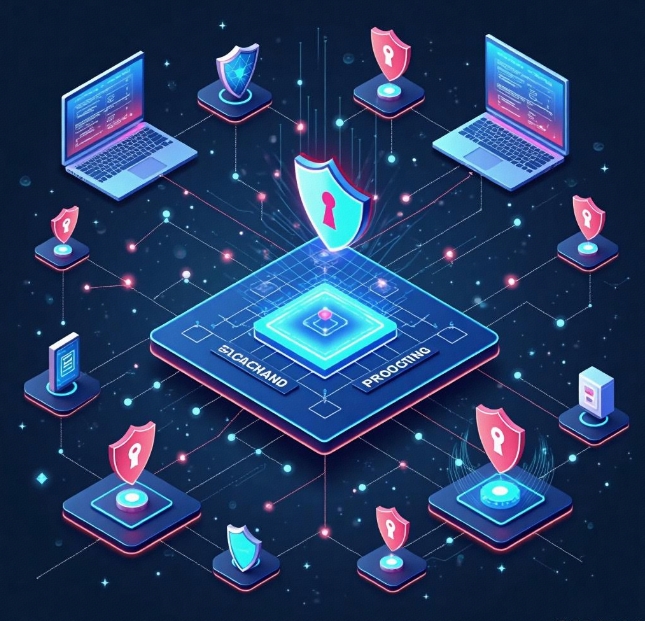Security Challenges and Protective Measures in DApp Development
- latest articles
- 1.DApp Development & Customization: Merging Diverse Market Needs with User Experience 2.Analysis of the Core Technical System in DApp Project Development 3.How to achieve cross-chain interoperability in Web3 projects? 4.How does the tokenization of points reconstruct the e-commerce ecosystem? 5.How to Set and Track Data Metrics for a Points Mall? 6.What is DApp Development? Core Concepts and Technical Analysis 7.Inventory of commonly used Web3 development tools and usage tips 8.Development of a Distribution System Integrated with Social E-commerce 9.Six Key Steps for Businesses to Build a Points Mall System 10.What is DApp Development? A Comprehensive Guide from Concept to Implementation
- Popular Articles
- 1.Future Trends and Technology Predictions for APP Development in 2025 2.Analysis of the DeFi Ecosystem: How Developers Can Participate in Decentralized Finance Innovation 3.From Zero to One: How PI Mall Revolutionizes the Traditional E-commerce Model 4.DAPP Development | Best Practices for Professional Customization and Rapid Launch 5.Recommended by the Web3 developer community: the most noteworthy forums and resources 6.From Cloud Computing to Computing Power Leasing: Building a Flexible and Scalable Computing Resource Platform 7.How to Develop a Successful Douyin Mini Program: Technical Architecture and Best Practices 8.Shared Bike System APP: The Convenient Choice in the Era of Smart Travel 9.How to Create a Successful Dating App: From Needs Analysis to User Experience Design 10.From Design to Development: The Complete Process of Bringing an APP Idea to Life
With the widespread application of blockchain technology, decentralized applications (DApps) have gradually become an important component of the blockchain ecosystem. Compared to traditional centralized applications, DApps offer advantages such as decentralization, no need for trusted intermediaries, and transparency. However, security issues remain a significant challenge that cannot be overlooked during DApp development. The security of DApps not only directly affects the stability of the application and user trust but also involves the security of assets and the protection of user privacy. This article will explore the security challenges in DApp development and their protective measures, helping developers increase their awareness of security issues and adopt effective safeguards to ensure the security of DApps.
I. Basic Concepts and Architecture of DApps
DApps (Decentralized Applications) are applications built on blockchain technology, typically characterized by decentralization. DApps implement their core functions through smart contracts and blockchain networks, without relying on traditional centralized servers or third-party intermediaries.
The basic architecture of a DApp usually consists of the following components:
Frontend: The user interface part of the DApp, typically a web page or mobile application that users access via a browser or mobile device.
Smart Contract: The core part of the DApp, smart contracts are program codes on the blockchain used to execute the logic of the DApp and handle data storage and exchange.
Blockchain Network: The blockchain network provides a decentralized data storage and verification mechanism, ensuring that the execution of smart contracts is transparent and fair.
The decentralized nature of DApps gives them many advantages but also introduces numerous security challenges. Due to their decentralized characteristics, DApps typically rely on the security of the blockchain and smart contracts, and any vulnerabilities or flaws can lead to serious consequences.
II. Security Challenges in DApp Development
During the development of DApps, numerous security challenges arise, stemming not only from the smart contracts themselves but also from the blockchain network, user clients, and development tools. Below are some common major security challenges in DApp development:
1. Smart Contract Vulnerabilities
Smart contracts are the core components of DApps, and their code logic is typically written by developers. However, since smart contracts cannot be modified once deployed on the blockchain, if there are vulnerabilities or errors in the smart contract, attackers can exploit these vulnerabilities. Here are some common smart contract vulnerabilities:
Reentrancy Attack: Attackers repeatedly call the contract through nested calls while certain operations are incomplete, leading to abnormal contract states. For example, the famous The DAO attack was achieved through a reentrancy vulnerability.
Integer Overflow/Underflow: If the smart contract does not perform proper input checks, attackers can pass integer values beyond the acceptable range, causing overflow or underflow and disrupting the contract's normal logic.
Timestamp Dependency: If a smart contract relies on block timestamps for certain operations, attackers can manipulate the contract's behavior by controlling the miner's timestamp.
Access Control Vulnerabilities: If the contract does not implement proper permission controls, attackers may modify sensitive data or perform unauthorized operations through unauthorized access.
2. Risks in Contract Interaction with External Systems
Many DApps need to interact with external systems, such as other contracts, oracle services, and decentralized storage. The security of these external systems is often beyond the developer's control, so interactions with them can introduce security risks. For example, if the data returned by an oracle is tampered with, it may affect the DApp's decision-making logic, leading to significant financial losses.
3. Client Security
The security of DApps depends not only on the security of smart contracts and the blockchain but also on the security of the client side. DApps typically require users to interact through digital wallets, which necessitates that the client-side digital wallets are sufficiently secure. However, aspects such as private key management, device security, and browser plugin security can become targets for attackers. Common client-side security issues include:
Private Key Leakage: If a user's private key is leaked, attackers can steal the user's digital assets. Protecting private keys is the most basic security requirement for DApp users.
Phishing Attack: Attackers trick users into entering their private keys or seed phrases by forging DApp websites or wallet applications, thereby stealing the user's digital assets.
Malicious Browser Plugins: Some malicious browser plugins may steal users' private keys or send unauthorized transactions, threatening the security of their assets.
4. Security of the Blockchain Network
Although the blockchain itself is highly secure and decentralized, the blockchain network still faces potential security risks. For example, 51% attacks, network forks, and transaction volume attacks can all affect the security of DApps. Additionally, performance bottlenecks of the blockchain network (such as transaction processing speed and high fees) may prevent DApps from meeting users' actual needs.
III. Security Measures in DApp Development
Faced with various security challenges in DApp development, developers must adopt a series of effective protective measures to ensure the security of DApps. Below are some common security measures:
1. Smart Contract Code Auditing
Once a smart contract is deployed on the blockchain, it cannot be modified, so the contract's code must undergo rigorous auditing. Developers should regularly conduct code audits of contracts and use professional security auditing tools for automated checks. Additionally, developers can engage third-party security auditing agencies to conduct comprehensive security testing of smart contracts, identifying and fixing potential vulnerabilities.
2. Preventing Reentrancy Attacks
To prevent reentrancy attacks, developers can use the "Check-Effect-Interaction" design pattern. This pattern requires the smart contract to check conditions and update the state before executing external calls, thereby preventing attackers from repeatedly calling the contract while the state is not updated.
3. Using Secure Math Libraries
To prevent integer overflow and underflow issues, developers can use verified math libraries (such as OpenZeppelin's SafeMath library) for mathematical operations. These libraries provide secure arithmetic operations, ensuring that no overflow or underflow occurs during numerical computations in the contract.
4. Strengthening Access Control
Developers should implement strict permission management and access control mechanisms in smart contracts. For example, using role-based access control (RBAC) to restrict the operational permissions of different users, ensuring that only authorized users can perform sensitive operations.
5. Enhancing Client Security
Client security should not be overlooked. Developers should help users protect their private keys by providing secure digital wallet services and strengthening user authentication. At the same time, user education should be enhanced to raise awareness of security threats such as phishing attacks and malicious plugins.
6. Using Multi-Signature and Cold Wallets
For high-value DApps, developers should consider using multi-signature technology for asset protection. By setting multiple signature thresholds, certain sensitive operations can only be executed with the authorization of multiple signers. Additionally, cold wallets can effectively prevent hackers from stealing digital assets through network attacks.
7. Choosing Reliable Blockchain Platforms
Choosing a secure and reliable blockchain platform is crucial for the security of DApps. Developers should select mature and widely validated blockchain platforms, such as Ethereum and Polkadot, while also paying attention to the platform's performance, scalability, and potential security issues.
8. Regular Updates and Maintenance
The security of DApps is a dynamic process. As attack methods continue to evolve, developers should regularly update and maintain DApps. Regularly fixing vulnerabilities, updating dependent libraries and tools, and promptly responding to security incidents are necessary measures to ensure the long-term secure operation of DApps.
IV. Conclusion
As one of the core applications of blockchain technology, DApps offer advantages such as decentralization and transparency but also face numerous security challenges. Vulnerabilities in smart contracts, security risks on the client side, and risks in interactions with external systems can all threaten the security of DApps. Developers must remain vigilant about these security challenges and adopt effective protective measures to ensure the security of DApps and users' digital assets. By strengthening smart contract audits, enhancing client security, and carefully selecting blockchain platforms, the security risks of DApps can be significantly reduced, providing users with a safer and more reliable decentralized application environment.
-

DApp Development & Customization: Merging Diverse Market Needs with User Experience
As blockchain technology matures and becomes more widespread, decentralized appl···
-

Analysis of the Core Technical System in DApp Project Development
With the rapid development of blockchain technology, decentralized applications ···
-

What is DApp Development? Core Concepts and Technical Analysis
With the rapid development of blockchain technology, decentralized applications ···

 Blockchain
Blockchain












